|
Some good bird sightings in our area:
| Surf Scoter (female in early morning darkness) |
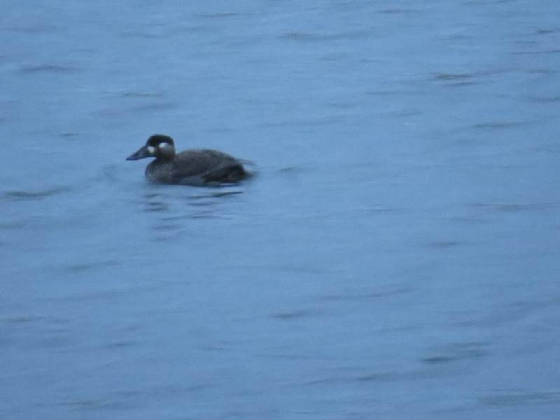
|
| Bacon Creek Park by Rob Towler |
11-1-2017=Surf Scoter found at Bacon Creek Park in Sioux City,
Woodbury County Iowa.
On 11-1-2017, 2 local birders found
a Surf Scoter at Bacon Creek Park in Sioux City, Woodbury County, Iowa and it was present for a couple days. The National
Geographic Field Guide to the Birds of North America lists the Range of this bird as: nests on Tundra and in wooded areas
near water—rare inland migrant—a few winter on Southern Great Lakes—most in Coastal waters. The Iowa Ornithologists
Union lists this bird as a regular visitor to Iowa and it is most often seen during the months of October and November.
The Surf Scoter is a Sea Duck common on the Pacific and Atlantic coasts
in winter. It migrates in flocks. When migrating overland to coastal wintering areas, usually flies high. Stopovers on lakes
inland apparently are mostly for resting, not for feeding. This duck was a female which is not as colorful as the male but
still a rare find in our area.
| Eurasian Wigeon |
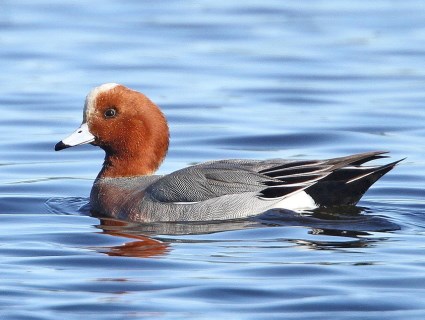
|
| One of these was found at Owego Wetlands 4-17-2017 |
4-17-2017=Eurasian Wigeon found at Owego Wetlands in Woodbury
County Iowa.
On 4-17-2017, 2 local birders found
a Eurasian Wigeon at Owego Wetlands in Woodbury County, Iowa and it was present through 4-21-2017. The National Geographic
Field Guide to the Birds of North America lists the Range of this bird as: Rare but regular winter visitor along both coasts,
more common in the West, rare in interior of North America. Regular migrant in western AK, a few winter in the Aleutians.
The Iowa Ornithologists Union lists this bird as an accidental visitor to Iowa. Several local birders were able to view this
rare visitor to our area and it was a life bird for some and a first in Iowa bird for others. A few birders from other areas
of the state also came to see this bird.
The Cornell Lab Of Ornithology states:
Common and widespread in the Old World, the Eurasian Wigeon is a sporadic visitor to North America.
Regular in very small numbers along the Pacific and Atlantic coasts, single individuals have turned up in nearly all states
and provinces. This was an exciting bird to see for local birders and shows again that you never know what you might find
while out birding!
| Burrowing Owl in Monona County, Iowa |
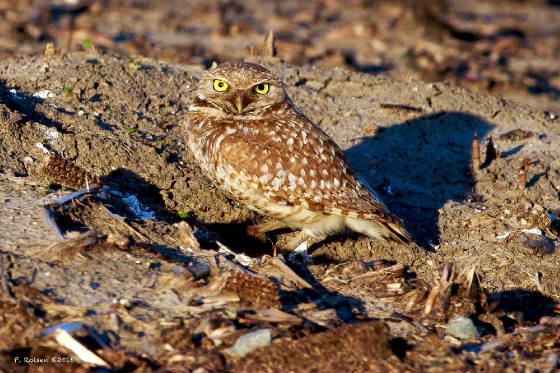
|
| By Paul Roisen |
5-4-2016=Burrowing Owl found in farm field in Monona County, Iowa.
On 5-4-2016, local birders found a
Burrowing Owl in a farm field Southwest of Sloan in Monona County, Iowa and it was present through 5-14-2016. It was using
an abandoned Badger hole near a gravel road so was easy to see. Per the Cornell Lab Of Ornithology, Owls are unmistakable
birds, and that goes double for a long-legged owl that hunts on the ground during the day. Burrowing Owls are small, sandy
colored owls with bright-yellow eyes. They live underground in burrows they’ve dug themselves or taken over from a prairie
dog, ground squirrel, or tortoise. They live in grasslands, deserts, and other open habitats, where they hunt mainly insects
and rodents. Their numbers have declined sharply with human alteration of their habitat and the decline of prairie dogs and
ground squirrels. The Iowa Ornithologists Union lists this bird
as a casual visitor to Iowa.
| Pine Grosbeak |
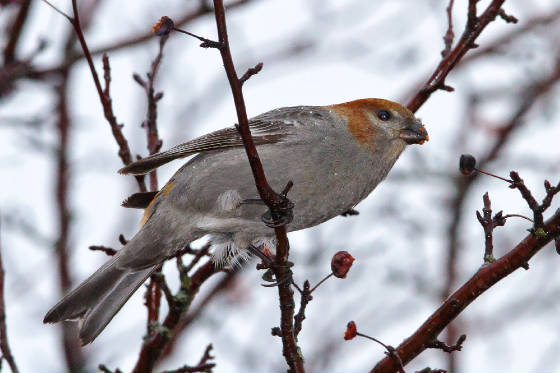
|
| Sheldon Cemetery by Paul Roisen |
| Red Crossbill and White-winged Crossbill |
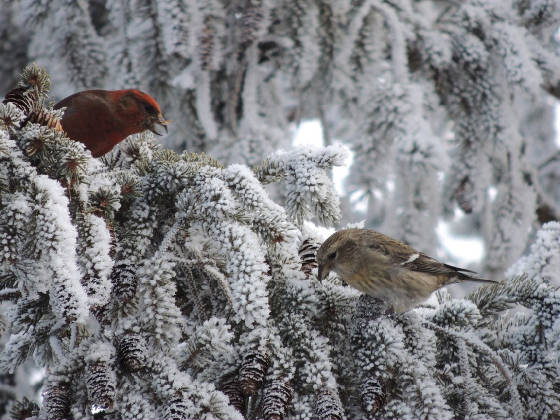
|
| Sheldon Cemetery by Jan Null |
During the winter of 2015-2016, Pine Grosbeaks, Red Crossbills,
and
White-winged Crossbills were found at a cemetery in Sheldon, IA. They were
present for several weeks. Those 2 species of Crossbills were also found at
Graceland Cemetery in Sioux City, IA. and were also present for several weeks.
Many local birders
and out of town
birders were able to see and enjoy these uncommon visitors to Iowa. Per the
Cornell Lab Of Ornithology, the Pine Grosbeak is a bird of the boreal
forests, found across northern Eurasia and North America, and south into the
mountains of western Canada and the United States. A large, unwary finch, it
makes periodic winter irruptions into southern Canada and northern United
States. It is the largest and rarest of the "winter finches." The Iowa
Ornithologists Union lists this bird as an accidental visitor to Iowa.
The Red Crossbill is described as a stocky finch of
mature coniferous forests and is dependent on the seed cones that are its main
food. Its peculiar bill allows it access to the seeds, and it will breed
whenever it finds areas with an abundance of cones. It may wander widely
between years to find a good cone crop. The White-winged Crossbill is described
as a medium-sized finch of the boreal forest and is adapted for extracting
seeds from the cones of coniferous trees. It moves large distances between
years tracking the cone crop from place to place. The Iowa Ornithologists
Union lists both of these Crossbills as regular
visitors to Iowa, but it is always a treat to find them in our area extracting
the seeds from the pine cones and then dropping the cones under the tree!
| 6-28-14=Black-bellied Whistling-ducks by Jan Null |
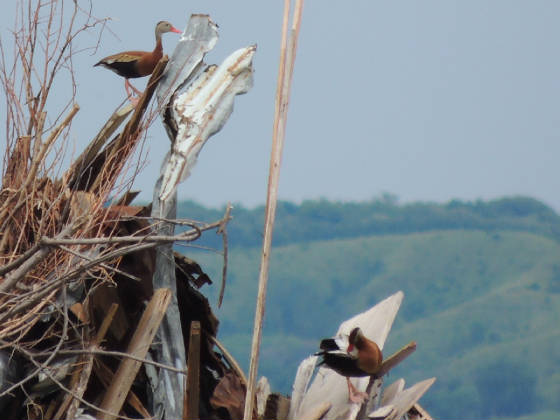
|
| Woodbury County (after they flew from farm pond) |
6-28-2014=Black-bellied
Whistling-ducks found in flooded farm field in Woodbury County, Iowa.
On 6-28-2014, local
birders found 2 Black-bellied Whistling-ducks in a flooded farm field in
Woodbury County, Iowa (about 2 miles west of Owego Wetlands) and they were
present through 6-29-2014. Per the Cornell Lab Of Ornithology, these ducks are
common south of the U.S. and occur in several southern states and are expanding
northward. It is a boisterous duck with a brilliant pink bill and an unusual,
long-legged silhouette. They roam edges of shallow ponds, frequent agricultural
fields and really do have a whistle for their call. The Iowa Ornithologists
Union lists this bird as a casual visitor to Iowa.
| Cinnamon Teal with Blue-winged Teal |
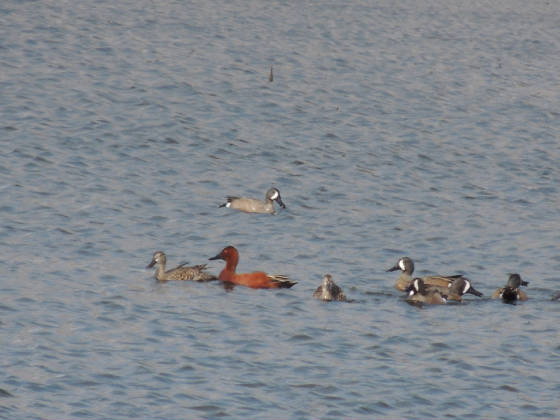
|
| Badger Lake, Monona County 4-21-2014 by Jan Null |
4-21-2014=Cinnamon
Teal Found At Badger Lake in Monona County, Iowa.
On 4-21-2014, local
birders found a Cinnamon Teal at Badger Lake in Monona County, Iowa. Per the
National Geographic Field Guide this bird is a westerly species and a casual
visitor to our area. The beautiful Cinnamon Coloration of this duck certainly
stands out when in the company of the abundant Blue-winged Teal that migrate
through our area. Males have red-orange eyes and give a chattering call.
| Worm-eating Warbler |
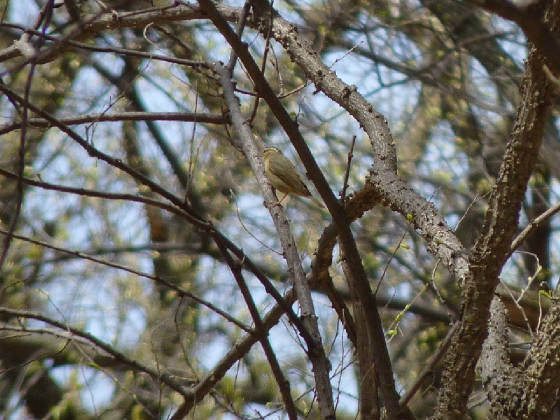
|
| By Tucker Lutter |
5-13-2013=Worm-eating
Warbler Found In Stone State Park. On 5-13-2013, a local birder found a Worm-eating Warbler in the
Pammel Valley area of Stone State Park. The park is located just northwest of Sioux City, Iowa.
Per the National Geographic Field Guide the range of this bird is the southeastern United States
and up to the Mississippi River area of eastern Iowa. It
is found chiefly in dense undergrowth on wooded slopes and often feeds
in clusters of dead leaves. It is a casual vagrant in California and the southwest. It has bold,
dark stripes on a rich buffy head, upperparts brownish-olive; underparts buffy; long, spikelike
bill. Song is a series of sharp, dry chip notes like Chipping Sparrows but faster.
The bird was in the area for a few hours and viewed by several local birders but was
not found in the next few days. This is thought to be only the 2nd sighting of this bird
in Woodbury County.
| Common Redpolls |

|
| By Loren Hansen |
WINTER 2012/2013 COMMON REDPOLLS IRRUPTION.
Common Redpolls have invaded Siouxland and the state of Iowa. Numerous flocks of various sizes have been seen
locally during CBC’s (Christmas Bird Counts) and by individual birders at conservation areas such as the Owego Wetlands.
People with niger and sunflower type feeders have also enjoyed finding this pretty little visitor with a red cap and black
chin at their feeders. The male usually has a bright rosy breast and sides. Per the National Geographic field guide this bird
breeds in subartic forests and tundra scrub. It forms large winter flocks and frequents brushy, weedy areas, also catkin-bearing
trees like alder and birch. Its song combines trills and twittering.
| Snowy Owl |
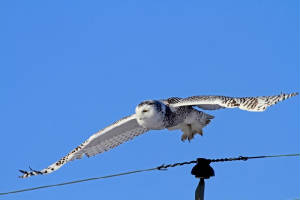
|
| By Don Poggensee |
FALL/WINTER 2011 SNOWY OWLS IRRUPTION!!
Snowy Owls have invaded Iowa and surrounding states! A few were sighted in November and the sightings have
increased greatly in December. The Iowa Ornithologists’ Union (IOU) has been tracking the sightings reported by birders
across the state of Iowa and attempting to the best of its ability to not count the same birds twice. As of Christmas day
2011, 61 Snowy Owls have been reported in Iowa. Sadly, there have also been some mortalities with 9 being reported through
that same date. (Including one on old hwy 75 just north of Salix). The IOU Home Page at htttp://www.iowabirds.org/ contains
a map of where the Owls have been reported in Iowa and where the mortalities have occurred.
This is a very unusual occurrence and birders across the state have been out taking advantage of the opportunity
to see this magnificent visitor from the far north. There are years when none are seen this far south, and years when small
irruptions of a few occur but this year has seen a large number in Iowa. Irruptions occur when the food supply is not sufficient
for their survival, so they move south to look for food. It was reported that due to a recent good food supply there was a
very good reproduction of the Owls and then the food supply crashed and now they have been forced to move south.
According to the National Geographic Field Guide, Snowy Owls are an Owl of open tundra; nests on the ground;
preys chiefly on lemmings, hunting by day as well as at night. It is a large white Owl with yellow eyes. Dark bars and spots
are heavier on females, heaviest on immatures. Old males may be pure white. A bird of the Artic Tundra, it retreats from northernmost
part of range in winter. In years when the lemming population plummets, Snowy Owls may wander in winter as far south as northern
Alabama, Oklahoma and central California. These irruptives, usually heavily barred younger birds, often perch conspicuously
on the ground or on low stumps, fence posts and buildings. (In Iowa they seem to also like hi-line poles and round grain bins).
Several have been seen locally in Woodbury County with up to 5 seen in a small area and perhaps at least a
dozen or more overall in Woodbury. Local birders have been out taking advantage of this rare opportunity and other birders
from across the state have come to our area also. Most of those seen have been immatures but a couple have shown the almost
white coloring of an adult. This is indeed a good time to enjoy this beautiful bird from the far north! Who knows when it
will return again??
July/August 2011--BLACK-NECKED STILTS. On 21 July, Black-necked
Stilts were spotted in a flooded corn stubble field along Nebraska Highway 35 east of Hubbard, Dixon County, NE. Several local
birders were able to see their first local stilts and to eventually locate up to 9 adult birds, two incubating pairs, one
nest with 4 eggs and a lingering pair with a juvenile on 6 August, which was later found to be 2, and then 3 juveniles by
27 Aug.
These precocial young leave the nest immediately upon hatching and feed themselves
under the watchful eyes of the vigilant parents, who were observed driving away Killdeer, Lesser Yellowlegs and Red-winged
Blackbirds. Expected to fledge at 28-32 days, the young, when they were about 25 days old, were under the watch of one adult,
the other suspected of beginning migration as did the other 7 adults in mid August, typical for the species.
These stilts were found in an area that would normally be covered with corn
and beans, but due to The Great Missouri River Flood of 2011 the corn and bean fields had been obliterated and another habitat
seldom seen in the Missouri River floodplain in late summer was created, that being the flooded row crop and pasture ground
in the lower elevations of the floodplain. These flooded, playa type wetlands provided an enticement for an unprecedented
breeding attempt by Black-necked Stilts, usually spending their summers in distant western alkali playas or coastal locations.
Per the National Geographic Field Guide, the Black-necked Stilt is a more
westerly and southern species. The male’s glossy black back and bill contrast sharply with white underparts and long
red or pink legs. It breeds and winters in a wide variety of wet habitats. Its breeding range is spreading north and it is
casual north to Great Lakes.
2011 OSPREY NEST ACTIVITIES (As of August 27, 2011)
The nest near Brown’s Lake in Woodbury County has fledged 1 young and the nest south of Sloan in Monona County has
fledged 3 young. (See the earlier report below on July 19).
2011 OSPREY NEST ACTIVITIES (As of July 19, 2011)
A pair of Osprey have returned to both nests south of Sioux City.
The nest near Brown’s Lake in Woodbury County hatched 2 young but 1 seems to have disappeared. The 1 remaining young
is good sized and has been seen exercising its wings and appears to be close to flying. This is the 4th year for
this nest and it has produced a total of 8 young over the last 3 years.
The nest south of Sloan in Monona County hatched 3 young and all 3 are still present and accounted for. They are also good
sized and one of them was seen standing in the nest and exercising its wings and appears to be close to flying. This is the
2nd year (as far as we know since it was discovered late last year) for this nest and it produced 2 young last
year.
12-07-2010=A Ross’s Gull was found at Gavin’s Point Dam in Yankton S.D. on November 26, 2010 and was
still present as of 12-07-2010. This bird is very rare in our area. The National Geographic Field Guide to the Birds
of North America states that the Ross’s Gull is an East Siberian Artic species. It is a common fall migrant along the
northern coast of Alaska, presumably winters at sea, and is casual south to the northern U.S. Several birders from wide ranging
areas of the U.S. have come to see this bird from the far north!
8-21-2010=3 Yellow-crowned Night-herons
were found at Sandhill Lake in Woodbury County SW of Salix. Per the National Geographic Field Guide, this bird is a more southerly
species and is a casual visitor to our area. These birds were juveniles and displayed striking red eyes.
An amazing number of 11 juvenile Yellow-crowned Night-herons were observed at this same
sight on the evenings of 8-23-2010 and 8-24-2010!!
8-20-2010=A Second Osprey Nest Found In Our Area!
An Osprey nest was found south of Sloan in Monona County. There
were 2 young and an adult at the nest. This nest is about 10 miles SE of the other Osprey nest near Brown’s Lake that
has produced a total of 8 young over the last 3 years. This is most likely the 1st confirmed nesting of Osprey
in Monona County since European settlement!
2010 Osprey Nest Activities
Due to safety concerns, the Osprey nest on the communications
tower north of Brown’s Lake that fledged 3 young in 2008 and 3 young in 2009 was removed in the fall of 2009. The question
was: will the Osprey pair return and nest in 2010? The answer is yes and their return and nesting activities are summarized
below.
4-3-2010=A single Osprey was seen
on the tower.
4-4&5-2010=An Osprey pair was
observed at the site rebuilding the nest.
4-16-2010=Pair on nest--one flew
and returned with a stick--the nest is looking better!!
5-4-2010=Was raining--could see head
of one on nest--2nd one flew in with a small fish and was tearing it apart and eating it.
5-20-2010=Both adults on the nest--they
appear to be sitting on eggs?
6-11-2010=Both adults on nest and
1 appeared to be feeding young.
6-22-2010=One adult on nest and one
on tower--saw the dark heads of 2 good sized young!
7-14-2010=Both adults on tower--2
large young in nest preening.
7-20-2010=Both adults on tower and
the 2 young are standing tall in the nest.
7-23-2010=Both adults on tower and
2 young on nest exercising their wings.
8-3-2010=The 2 young have fledged!
| Ruddy Turnstone |
|
|
| By Paul Roisen |
On 5-11-2010, a beautiful Ruddy Turnstone
in breeding plumage was found at a dairy pond north of Luton in Woodbury County. Per the National Geographic Field Guide,
this bird nests on coastal tundra and is a rare inland migrant except in the Great Lakes region. Striking black-and-white
head and bib , black-and-chestnut back, and orange legs mark this stout bird in breeding plumage. Turnstones use their slender
bills to flip aside shells and pebbles in search of food.
4-21-2010 thru 5-11-2010=LUTON WILDLIFE AREA SOUTH in Woodbury
County=Three beautiful birds
that are rare to our area have been seen at this wetland in the last three weeks.
A CINNAMON TEAL was found on 4-21-10.
Per the National Geographic Field Guide, the Cinnamon Teal is a more westerly species. It is common in marshes, ponds, lakes,
regular from eastern great plains south to east Texas, casual to eastern Midwest and east. This bird was a handsome adult
male in cinnamon color with a red eye.
A BLACK-NECKED STILT was found on 5-8-10.
Per the National Geographic Field Guide, the Black-necked Stilt is a more westerly and southern species. The male’s
glossy black back and bill contrast sharply with white underparts and long red or pink legs. It breeds and winters in a wide
variety of wet habitats. Its breeding range is spreading north and it is casual north to Great Lakes.
A LITTLE BLUE HERON was found on 5-11-10.
It was an adult in breeding plumage. Per the National Geographic Field Guide, the Little Blue Heron is a more southerly species.
In high breeding plumage head and neck become reddish-purple, legs and feet black. They are slow methodical feeders and disperse
north in spring and during post-breeding dispersal.
| Black-necked Stilt |
|
|
| By Tucker Lutter |
| Little Blue Heron |
|
|
| By Tucker Lutter |
January 2010:For
the 2nd year in a row, a PRAIRIE FALCON was
found near the dairy farm just south of Luton, IA., in Woodbury
County. It was 1st seen on January 27th. Then on January 30th, Two
Were Found in that area. One captured a starling and landed in a nearby field to feed and was joined by a 2nd one on the
ground. They were still present into early March. The one found last year was 1st seen on February 12, 2009.
This
bird is another welcome winter visitor to our area! Per the National Geographic Field Guide, it preys chiefly on birds and
small mammals. It inhabits dry, open country, prairies and is a more westerly species. It is a rare migrant and winter visitor
to the ‘western’ midwest. Falcons are powerful hunters and are distinguished from hawks by their long wings which
are bent back at the wrist and narrow and pointed.
| Tufted Titmouse-Bronson, IA. |
|
|
| By Tucker Lutter |
11/17-23/2009=Tufted Titmouse at feeder in Bronson, IA.
On 11-17-2009 a Tufted Titmouse was found at a feeder in Bronson,
IA. It was present at least until 11-23-2009. The National Geographic Field Guide states that this bird is active and noisy
and its typical song is a loud whistled peter-peter-peter. This bird was certainly living up to its reputation. In its range
it is common in deciduous woodlands, mesquite, parks, suburbs and feeders. Although commonly found in southern and eastern
Iowa, it is a rare visitor to northwest Iowa and it was a life bird for Woodbury County for several of the birders who were
fortunate to see it.
| Scissor-Tailed Flycatcher--Luton, IA. |
|
|
| By Tucker Lutter |
Scissor-Tailed Flycatcher
In Woodbury
County 10/25-26/2009.
A
beautiful, adult Scissor-Tailed Flycatcher was found in the town of Luton,
IA on 10-25-2009 and was present through 10-26-2009. The National Geographic Field Guide states that this bird is found in
semi-open country and is a rare to casual wanderer in much of North
America. Its usual range is further to the southwest in the states of Kansas,
Oklahoma, and Texas. This
bird had colorful, salmon pink sides and was foraging in a grassy area near the road and put on quite a show flying and perching
at times on the hi-line or hay bales or weed stalks. The last known STFC in Woodbury
County was a juvenile found at the Owego Wetlands on October 2, 2006.
10-26-2009=Northern Goshawk at Luton, IA.
While viewing the Scissor-tailed Flycatcher on 10-26-2009
in Luton, IA., a beautiful, adult, Northern Goshawk was also found in the area perched in a nearby tree. The National Geographic
Field Guide states that the NOGO inhabits deep conifer-dominated, mixed, woodlands and preys on birds and mammals as large
as hares. Its normal range includes Canada and some western states. It is an uncommon, winter, visitor to our area.
10-25-2009=Smith’s Longspurs at Luton Wildlife
Area North.
On 10-25-2009 a large flock of Smith’s Longspurs were found at Luton Wildlife Area North.
Up to 104 were counted at one time. The National Geographic Field Guide states that this Longspur nests on open tundra and
damp tussocky meadows in the far north. It is generally uncommon and secretive, especially in migration and winter. It winters
in open, grassy areas and this is the habitat it was found in at L.W.A. North. You can almost step on them before they fly
and disappear again in the grass. They make a sharp, dry, ticking, rattle when flushed and their outer tail feathers are visibly
white when flying.
May 2009, Woodbury County,
IA
An OSPREY pair has
returned to the nest near Brown's Lake where they nested and fledged 3 young last year. The pair was observed in early
April adding nesting materials to last year's nest. In early May they appeared to be sitting on eggs, so we will watch and
see if they are successfull in fledging more young again this year!
July 2009--3 young Osprey were confirmed in the nest!
July 25, 2009--Both adults were on the tower and the 3 young were in the nest! One of the young flew around the tower a few times and landed on the tower about
5 rungs below the nest. (It seemed to be having a hard time getting back up to the nest). A second young was exercising its
wings and flying up above the nest just a short distance and coming back down into the nest. The 3rd young was hunkered down
low in the nest most of the time but did come up higher in the nest later on. It is most likely the youngest of the 3.
August 9, 2009--All 3
young were present at the nest area. All 3 have been seen flying. It appears to be a
successfull nesting with 3 young fledged for the 2nd straight year!
May 2009 Ida Co., IA
A SURF SCOTER was found in early May at Crawford Creek Recreation Area in Ida county. This rare
inland migrant is rare in our area.
April 2009 Woodbury Co., IA
A SANDHILL CRANE was found in late April 2009, at Sandhill Lake which is an old oxbow southwest
of Salix, IA. This bird is not commonly seen in our area.
April 2009 Woodbury Co., IA
A SNOWY PLOVER was found in late April 2009 at a dairy pond southeast of Luton, IA . This bird
is rare in Iowa, but a second one was also seen about the same time in central Iowa. The National Geographic Field Guide shows
the range of this bird further to the southwest and west when it migrates north during the summer.
March 2009, Sioux City, IA
A Carolina Wren has been a regular visitor to the feeders of a Sioux City residence for several weeks. It was first seen
on November 11, 2008 and was still present on March 15, 2009. The National Geographic Field Guide states that the Carolina
Wren is found in the concealing underbrush of moist woodlands and swamps and in wooded suburbs. It is non-migratory, but after
mild winters, resident populations expand north of their normal range. After harsh winters, range limits retract. The range
map shows it residing in the southeastern portion of the United States and up to the southern half of Iowa. It sings a loud
vivacious, melodious song at any time of day or year.
Other local sightings of Carolina Wrens include Stone Park, South Ravine, and Ponca State Park, but it is unusual to have
one at a feeder on a regular basis for such a long period of time. On March 5th, it was also heard singing its
song several times. It is a little larger than the more common House Wren that migrates here to nest in the summer.
February 2009 Woodbury Co.,IA
A Prairie Falcon was found
near the dairy farm just south of Luton, IA., in Woodbury
County on February 12, 2009. It was 1st seen dive bombing
and aggressively interacting with a Red-tailed Hawk. It later flew to the field to the west and perched on the ground. It
then took off and flew to the dairy barns to the east and ‘strafed’ the thousands of starlings around the barns.
It did not appear to be hungry as it seemed more like it was just ‘playing’ with them. This bird was still present
on February 14 and may hang around awhile since it has a good food supply available.
This bird is another welcome winter visitor to our area! Per the National Geographic Field Guide, it preys chiefly
on birds and small mammals. It inhabits dry, open country, prairies and is a more westerly species. It is a rare migrant and
winter visitor to the ‘western’ midwest. Falcons are powerful hunters and are distinguished from hawks by their
long wings which are bent back at the wrist and narrow and pointed.
| Snowy Owl North Of Luton |
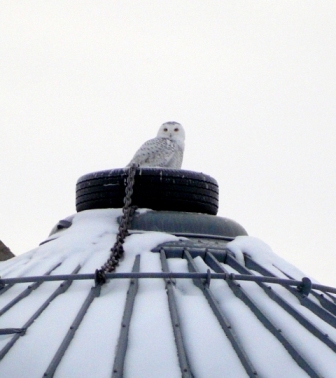
|
| By Tucker Lutter |
January 2009 Woodbury
Co.,IA
Woodbury
County has been blessed with some uncommon winter visitors the last half
of January. A SNOWY OWL was first discovered on January 26th near the Owego Wetlands Complex and a 2nd
SNOWY OWL was found the next day a few miles to the north at the Luton Wildlife Area north of Luton.
It’s unusual to have one, but to find two made it even more exciting! The Snowy near Owego was still present on February
14th, but the one north of Luton has not been seen recently.
Up to 9 Short-eared Owls have been
at Owego plus a flock of Common Redpolls, several Rough-legged Hawks, and Northern Shrikes. Roads in the area have also had
some Lapland Longspurs and good numbers of Snow Buntings. These nice sightings by area birders makes this long winter a little
easier to bear!
|

